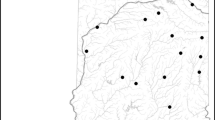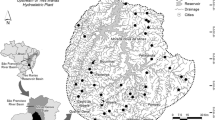Abstract
Macroinvertebrate community structure was compared in benthic samples taken by Surber and kick methods from a lotic system in south-western Australia. Eleven sites were sampled concurrently in winter, spring and summer 1987.
Surber samples contained fewer individuals and more taxa, particularly those with a low frequency of occurrence. This was attributed to the lower surface area, but greater intensity of Surber sampling. It is proposed that the Surber method is more suited to taking cryptic and closely adherent taxa in sites with a highly heterogeneous substratum.
Percentage similarity between paired Surber and kick samples was determined by Sorensen's and Czekanowski's coefficients, with mean values of 66% and 60% for June, 61% and 49% for September and 66% and 49% for December respectively. Ordination demonstrated a division of upland from lowland sites on axis 1, with a separation of paired-samples on axis 2. This pattern held across qualitative and quantitative datasets, with and without a downweighting on rare taxa. At each level of classification fewer paired-samples separated in qualitative than quantitative datasets.
Kick sampling provided a substantial saving in costs over Surber sampling, particularly when qualitative data were utilised, making the method suitable for routine, biological monitoring. However, the initial use of replicated Surber sampling, particularly in areas that have not been previously sampled is recommended for environmental impact studies to detect rare taxa, that may be endangered.
Similar content being viewed by others
References
Armitage, P. D., A. M. MacHale & D. C. Crisp, 1975. A survey of the invertebrates of four streams in the Moor House National Nature Reserve in Northern England. Freshwat. Biol. 5: 479–495.
Armitage, P. D., R. J. M. Gunn, M. T. Furse, J. F. Wright & D. Moss, 1987. The use of prediction to assess macroinvertebrate response to river regulation. Hydrobiologia 144: 25–32.
Boulton, A. J., 1985. A sampling device that quantitatively collects benthos in flowing or standing waters. Hydrobiologia 127: 31–39.
Bunn, S. E., 1986. Spatial and temporal variation in the macroinvertebrate fauna of streams of the northern jarrah forest, Western Australia: functional organization. Freshwat. Biol. 16: 621–632.
Bunn, S. E., D. H. Edward & N. R. Loneragan, 1986. Spatial and temporal variation in the macroinvertebrate fauna of streams of the northern jarrah forest, Western Australia: community structure. Freshwat. Biol. 16: 67–91.
Elliott, J. M., 1977. Some methods for the statistical analysis of samples of benthic invertebrates. Freshwater Biological Association, Scientific Publications No. 25.
Frost, S., A. Huni & W. E. Kershaw, 1971. Evaluation of a kicking technique for sampling stream bottom fauna. Can. J. Zool. 49: 167–173.
Furse, M. T., J. F. Wright, P. D. Armitage & D. Moss, 1981. An appraisal of pond-net samples for biological monitoring of lotic macroinvertebrates. Wat. Res. 15: 679–689.
Hellawell, J. M., 1986. Biological indicators of freshwater pollution and environmental management. Elsevier Applied Science Publishers, London and New York.
Hill, M. O., 1979a. DECORANA — A FORTRAN program for Detrended Correspondence Analysis and Reciprocal Averaging. Ecology and Systematics, Cornell University, Ithaca, New York.
Hill, M. O., 1979b. TWINSPAN — A FORTRAN program for arranging multivariate data in an ordered two-way table by classification of the individuals and attributes. Ecology and Systematics, Cornell University, Ithaca, New York.
Hornig, C. E. & J. E. Pollard, 1978. Macroinvertebrate sampling techniques for streams in semi-arid regions: comparison of the Surber method and a unit-effort traveling kick method. Environmental Monitoring Services of the United States Environmental Protection Authority No. 600/4-78-040, pp 20.
Hynes, H. B. N., 1970. The Ecology of Running Waters. Liverpool University Press, Liverpool.
Jutson, J. T., 1950. The physiography (geomorphology) of Western Australia, 3rd edn. Bull. Geol. Surv. W. Aust. 95: 1–366.
Macan, T. T., 1977. The fauna in the vegetation of a moorland fishpond as revealed by different methods of collecting. Hydrobiologia 55: 3–15.
Mackey, A. P., D. A. Cooling & A. D. Berrie, 1984. An evaluation of sampling strategies for qualitative surveys of macroinvertebrates in rivers, using pond nets. J. appl. Ecol. 21: 515–534.
Marchant, R., A. Metzeling, A. Graesser & P. Suter, 1985. The organization of macroinvertebrate communities in the major tributaries of the La Trobe River, Victoria, Australia. Freshwat. Biol. 15: 315–331.
Morgan, N. C. & H. J. Egglishaw, 1965. A survey of the bottom fauna of streams in the Scottish Highlands. Part 1. Composition of the fauna. Hydrobiologia 25: 181–211.
Moss, D., M. T. Furse, J. F. Wright & P. D. Armitage, 1987. The prediction of the macro-invertebrate fauna of unpolluted running-water sites in Great Britain using environmental data. Freshwat. Biol. 17: 41–52.
Ormerod, S. J. & R. W. Edwards, 1987. The ordination and classification of macroinvertebrate assemblages in the catchment of the River Wye in relation to environmental factors. Freshwat. Biol. 17: 533–546.
Peckarsky, B. L., 1984. Sampling the stream benthos. In A manual on methods for the assessment of secondary productivity in fresh waters. [Eds] Dowling, J. A. & Rigler, F. H. Blackwell Scientific Publications, Oxford. pp 131–160.
Resh, V. H., 1979. Sampling variability and life history features: basic considerations in the design of aquatic insect studies. J. Fish Res. Bd Can. 36: 290–311.
Storey, A. W. & D. H. D. Edward, 1989. Longitudinal variation in community structure of Chironomidae (Diptera) in two south-western Australian river systems. Proc. Xth Int. Symp. Chironomidae, Debrecen, Hungary. Acta Biol. Debr. Oecol. Hung. 3: 315–328.
Surber, E. W., 1937. Rainbow trout and bottom fauna production in one mile of stream. Trans. am. Fish. Soc. 66: 193–202.
Surber, E. W., 1970. Procedure in taking stream bottom samples with the stream square foot bottom sampler. Proc. 23rd Ann. Conf S. East. Assoc. Game and Fish Comm.
Townsend, C. R., A. G. Hildrew & J. Francis, 1983. Community structure in some southern English streams: the influence of physicochemical factors. Freshwat. Biol. 13: 521–544.
Wright, J. F., D. Moss, P. D. Armitage & M. T. Furse, 1984. A preliminary classification of running-water sites in Great Britain based on macro-invertebrate species and the prediction of community type using environmental data. Freshwat. Biol. 14: 221–256.
Author information
Authors and Affiliations
Rights and permissions
About this article
Cite this article
Storey, A.W., Edward, D.H.D. & Gazey, P. Surber and kick sampling: a comparison for the assessment of macroinvertebrate community structure in streams of south-western Australia. Hydrobiologia 211, 111–121 (1991). https://doi.org/10.1007/BF00037367
Received:
Accepted:
Issue Date:
DOI: https://doi.org/10.1007/BF00037367




